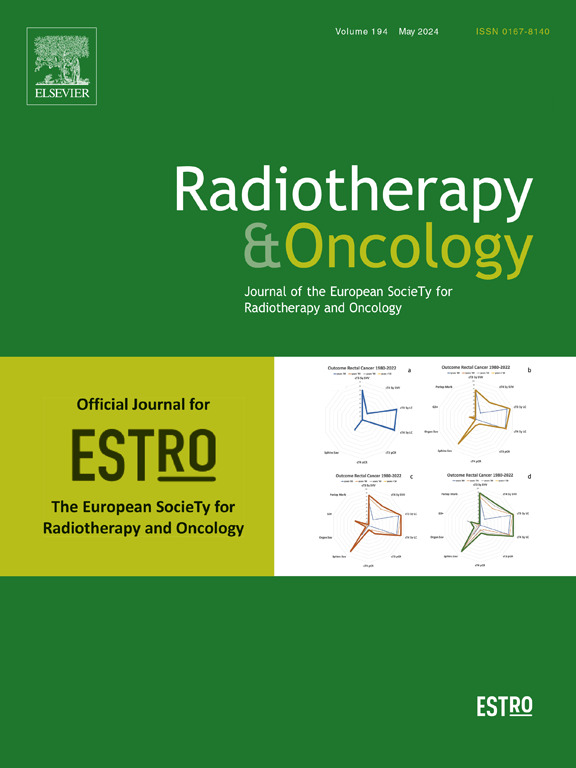描述不同氧合和辐射质量下超高剂量率下细胞生存反应的多尺度辐射生物物理随机模型
IF 4.9
1区 医学
Q1 ONCOLOGY
引用次数: 0
摘要
背景和目的虽然超高剂量率(UHDR)辐照的优势已在实验中得到充分体现,但FLASH效应的生物学机制仍不清楚,且存在很大争议。这项工作的目的是重现主要的体外超高剂量率辐照实验,并尝试解释健康组织和肿瘤之间不同的体内反应,为超高剂量率辐照机制开发一个完全一致的辐射生物物理模型。材料与方法我们开发了多尺度广义随机微剂量模型(MS-GSM2),它是 GSM2 的多阶段扩展,是一个描述受辐照细胞核中病变时间演化的概率模型。我们将缓慢的 DNA 损伤演变与快速的化学反应动力学结合起来,包括氧化还原环境的影响。我们证明,MS-GSM2 的预测结果与不同氧合水平和辐射质量下的体外 UHDR 实验结果是一致的。我们分析了辐照介质的化学环境条件(即含氧量和清除剂浓度)的作用,讨论了可能减弱或消除细胞存活的剂量率依赖性的因素,以了解正常组织和肿瘤在体内发生的不同效应。我们的模型为正常组织和肿瘤在体内和体外观察到的不同结果提供了一致的解释。本文章由计算机程序翻译,如有差异,请以英文原文为准。
A multiscale radiation biophysical stochastic model describing the cell survival response at ultra-high dose rate under different oxygenations and radiation qualities
Background and purpose
While the advantages of ultra-high dose-rate (UHDR) irradiation have been well highlighted experimentally, the biological mechanism underlying the FLASH effect is still unclear and highly debated. The aim of this work is to reproduce the main in-vitro UHDR experiments and to try to explain the different in-vivo response between healthy tissues and tumors, developing a fully consistent radiation biophysical model for UHDR regime.
Materials and methods
We developed the MultiScale Generalized Stochastic Microdosimetric Model (MS-GSM2), a multi-stage extension of the GSM2, which is a probabilistic model describing the time evolution of the lesions in an irradiated cell nucleus. We coupled the slow DNA damage evolution with the fast chemical reaction kinetics, including the impact of the redox environment.
Results
The MS-GSM2 can investigate the combined effects of chemical species, DNA damage formation and time evolution. We demonstrate that the MS-GSM2 predictions are coherent with the in-vitro UHDR experimental results across various oxygenation levels, and radiation qualities. We analyze the role of the chemical environmental conditions of the irradiated medium, i.e. oxygenation, and scavengers concentration, discussing possible factors that can attenuate or level out the dose rate dependence of the cell survival, to understand the differential effect that occurs in-vivo between normal tissue and tumor.
Conclusion
The MS-GSM2 can accurately describe multiple aspects of the FLASH effect and be consistent with the main evidence from the in-vitro experiments with different types of radiation and oxygenations. Our model proposes a consistent explanation for the differential outcomes observed in normal tissues and tumors, in-vivo and in-vitro.
求助全文
通过发布文献求助,成功后即可免费获取论文全文。
去求助
来源期刊

Radiotherapy and Oncology
医学-核医学
CiteScore
10.30
自引率
10.50%
发文量
2445
审稿时长
45 days
期刊介绍:
Radiotherapy and Oncology publishes papers describing original research as well as review articles. It covers areas of interest relating to radiation oncology. This includes: clinical radiotherapy, combined modality treatment, translational studies, epidemiological outcomes, imaging, dosimetry, and radiation therapy planning, experimental work in radiobiology, chemobiology, hyperthermia and tumour biology, as well as data science in radiation oncology and physics aspects relevant to oncology.Papers on more general aspects of interest to the radiation oncologist including chemotherapy, surgery and immunology are also published.
 求助内容:
求助内容: 应助结果提醒方式:
应助结果提醒方式:


